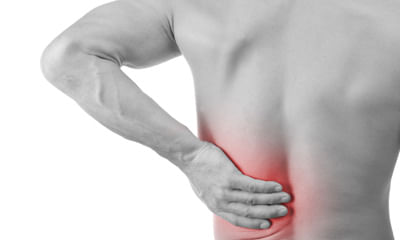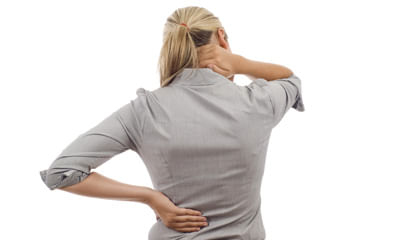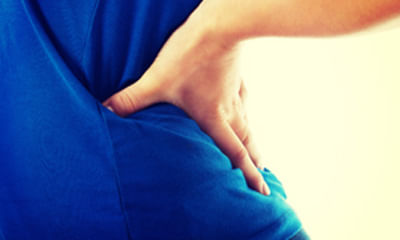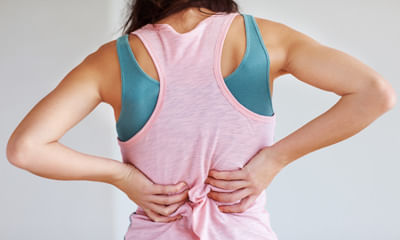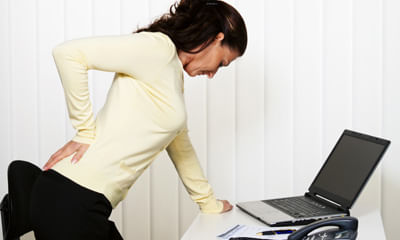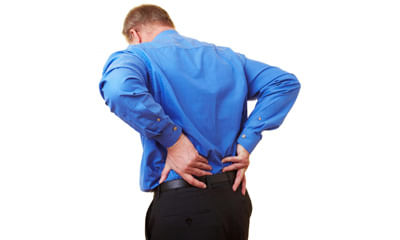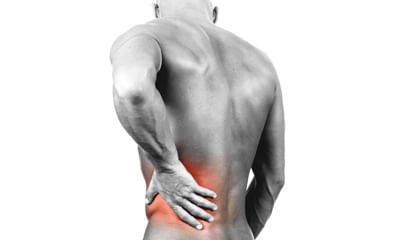Upper Rib Out Of Place
Asalamu alaikum Dr. shab 2 year ago I was pruning my orchard my right hand got tired I use my left hand unfortunately my ...
Ask Free Question
•mobility exercises rest. Avoid doing things that require you to bend at the hip or put a lot of pressure on the hip. Avoid sleeping on the side of your hip that is painful and sitting for long periods of time •cold and heat. Treating pain with heat and cold may help. Wrap an ice pack or a bag of frozen vegetables in a towel to ice your hip. A warm bath or shower may also help reduce your pain and prepare your muscles for stretching. •stretch. Gently stretching your body may reduce hip pain, especially if the cause is a strain or pinched nerve. 1. Knee lift1.Lie on the back, extending both legs flat along the floor. 2.Keeping the left leg straight, pull the right knee up toward the chest. 3.Place both hands on top of the knee to help pull it in toward the chest. 4.Hold the stretch for 10 seconds. 5.Let go of the knee and gently lower the leg back toward the floor. 6.Repeat this exercise 5–10 times on each knee. 2.double hip rotation 1.Lie flat on the back. Then, bend the knees and bring them toward the body until the feet are flat on the floor. 2.Gently rotate the knees to the left, lowering them toward the floor. Rotate the head to face the right while keeping the shoulders against the floor. 3.Hold this position for 20–30 seconds. 4.Slowly return both the head and knees to the starting position. 5.Repeat on the opposite side. 3.bridging 1.Lie on the back, bending both legs at the knee and placing the feet flat on the floor. Keep the arms by the sides of the body with the palms facing downward. If necessary, place a small pillow underneath the neck and head for support. 2.Slowly lift the pelvis and lower back upward. Be sure to keep the shoulders and upper body on the floor. 3.Hold the position for 5 seconds. 4.Gradually lower the back and pelvis toward the floor, starting at the top of the spine. Roll down through the spine until the entire back is flat against the floor again. 5.Repeat this exercise 5–10 times. 4.butterfly stretch 1.Sit on the ground, bend your legs, and bring the soles of your feet together so they touch, letting your knees fall out to the sides. 2.Bring your heels as close to your body as you can and lean forward into the stretch, using your elbows to gently push your knees toward the ground. 5.side lying leg raise 1.Lay on your right side with your legs straight and stacked on top of each other, propping yourself up with your elbow. If you’re using an exercise band, position it just above your knees. 2.Keeping your hips stacked, engage your core and lift your left leg straight up as far as you can. Slowly lower back down. Repeat on other side. 6.hip flexion 1.Stand upright. 2.Extend one arm out to the side and hold on to a sturdy surface, such as a wall, table, or chair, for support. 3.Slowly raise the right knee to the level of the hip or as far as is comfortable while keeping the left leg straight. 4.Only hold this position for a second before placing the left foot back on the floor. 5.Repeat with the left knee. 6.Do 5–10 repetitions of this exercise. 7.hip extension 1.Stand upright with the legs straight and the feet shoulder-width apart. 2.Extend both arms out in front and hold on to a chair, table, or wall for support. 3.Keeping the right leg straight, lift the left leg backward without bending the knee. 4.Lift the leg as far as possible without causing discomfort, then clench the buttock tightly and hold the position for 5 seconds. Repeat this stretch 5–10 times on each leg. To increase the resistance, try attaching small weights to the legs. 8.hip abduction 1.Stand upright. 2.Extend the left arm out to the side and hold on to something solid, such as a chair, table, or wall. 3.Starting with the feet together, lift the right leg out to the right side. Keep the left leg straight and avoid rotating the hips. 4.Hold the position for 5 seconds and then slowly return the leg to the starting position. Do this exercise 5–10 times on one leg, then repeat it on the other side.
Hello, I am having a sharp pain in the left mid side of my back under the rib cage at specific point when deep breathing ...
Ask Free Question
. Standing extension how it helps – this standing extension helps reverse what you do on a daily basis (hunching)… since most bulging discs and herniated discs are caused by poor posture and repeated flexion of the spine (esp bending fwd in bad posture), this stretch helps push the disc back to neutral position. How to do it – begin this exercise by standing up with good posture. Now take both hands and place them on both sides of your lower back. Now with the help of your hands push your pelvis forward and extend your spine back. Follow the extension with your neck so that you end up facing the ceiling. – start with 10 repetitions and do 2-3 sets. – this one is particularly great to do when you need a break from sitting at your desk. ** this should not cause any pain. If you feel pain during it is not a good one for you. In that case, stop and try some of the other exercises below instead. 2. Half cobra pose (prone lumbar extension) how it helps – the half cobra stretch helps to push the disc material back towards the center of the inter-vertebral disc to allow for improved healing. The goal of repeated lower back extension is the “centralization of symptoms”, which basically means pain that travels down the affected leg to the foot should come back up closer to the low back – which will in turn alleviate the pain. How to do it – begin this exercise by lying on your stomach (prone position) and slowly prop yourself up on your elbows while keeping your hips in contact with the floor. – hold the prop-up position for 10-15 seconds before returning to the prone position (lying face down). – gradually increase to holding the end position for 30 seconds. Aim for 10 repetitions of this stretch. ** initially, you may not be able to tolerate this position very well, so make sure you start slowly and carefully. If there’s any pain, try a different exercise instead. 3. Full cobra pose (advanced extension) how it helps – this stretch is based on the same principle as the half cobra pose above. This advanced extension helps to push disc material back towards the center of the intervertebral disc, with the goal of alleviating pain symptoms. How to do it – once you’ve mastered the half cobra pose, you can increase the difficulty by moving to the advanced version of this stretch. Begin this exercise by lying on your stomach in the prone position (lying facing down) and slowly press up on your hands while keeping your pelvis in contact with the floor and lower back relaxed. – hold the prop-up position for 10 seconds. Aim for 10 repetitions of this stretch. – eventually try to hold this pose for longer if it feels good (20-30 seconds). ** if you feel pain during this exercise, it is not a good one for you. In that case, stop and try some of the other exercises instead. 4. Cat-cow how it helps – this is one of the most popular herniated disc exercises. By combining two yoga poses, the cat-cow stretch can help to relieve pressure on the herniated disc by opening the intervertebral disc space. It also improves mobility of the spine, which may help to relieve disc herniation pain and speed recovery. How to do it – begin this stretch on your hands and knees. Inhale and let your stomach “drop” towards the floor as you look up towards the ceiling. – follow this by exhaling and slowly rounding your spine while pressing into the floor with your hands and slightly curving your neck to look at your feet. – aim for 10 repetitions of this stretch and do 2-3 sets. How it helps – this exercise will help strengthen and stabilize your lower back and deep spine muscles. This will help you to maintain a good posture and avoid future episodes of herniated discs. How to do it: – begin on your hands and knees with your hands positioned under your shoulders and knees positioned under your hips. – raise your left arm and reach it forwards until it is aligned with your torso; at the same time, kick your right leg backwards until is it aligned with your torso. – hold this position for 2-3 seconds before slowly returning to the starting position. – repeat with your right arm and left leg. – alternate sides for 10 repetitions and do 2-3 sets. ** ensure that your head, neck, and back maintain a neutral alignment to minimize stress on your neck. 5.plank: how it helps – just like the bird dog, this “core” exercise will help bring your pelvis into right position by strengthening the deep spinal muscles and glutes (butt muscles). How to do it – begin lying on your stomach with your forearms against the mat. – engage your core and lift your body so that you are resting on your forearms and toes. – start with 10 second holds and work up to 30 second holds, do 2-3 sets. ** ensure to keep your back straight throughout the entire exercise – spine in neutral position. Thoracic expansion if you’re using a chair, sit facing forward and allow your upper body to fall over the back of the chair. Extend your arms above your head for a deeper stretch. Hold either position for 10 seconds. 1. Plank the world record for the longest plank is 8 hours. Luckily, you don’t need to hold it that long for the exercise to have an effect! in fact. You can hold it for 10-15 seconds. • the plank is similar to a push-up position, but instead of resting on your hands, you rest on your elbows and bring them directly underneath your chest. • after kneeling, lean forward and place your elbows on the ground directly below your shoulders. • lift your knees off of the floor and push your feet back. Ensure your back is straight and keep your neck aligned with the rest of your spine. • hold the position and tighten your core muscles for the desired time. 2. Side plank just like the original plank, but only balancing on one side. • lie on the floor on your side, facing sideways with your feet together. • lift up your body until you are supporting yourself with your elbow, directly below your shoulder. • raise your hips until your body is in a straight line and tighten your core muscles; your body should create a slant from your shoulders to your feet. • hold this position without dropping your hips. • repeat on the opposite side. 3. Pelvic tilt with exercise ball sit on a ball that allows your legs to be at a 90-degree angle with your feet flat on the floor. • keep your shoulders back and spine straight. • tilt your hips forward and flex your abdominals tight. • tilt your hips backward as you stick your tailbone out. • move back and forth slowly, keeping your shoulders back. • repeat 10 times for 3 sets. 4. Superman lie on your stomach, face down, with your arms out in front of you. • lift arms, legs, and chest off the floor simultaneously while keeping your hips grounded. • hold for a minimum of two seconds. • lower back down slowly. • repeat 10 times for 3 sets. 6. Crunches lie flat on your back, placing your feet flat on the floor with your legs bent. • fold your arms across your chest and lift your torso up until your head, neck, and torso are off the ground. • hold for a moment before lowering back down. • repeat. 6. Quadruped arm opposite leg raises • kneel on the floor, lean forward, and place your hands palm-down on the floor. • make sure your back is straight, your knees are below your hips, and that your palms are directly below your shoulders. • raise one arm as you raise the opposite leg until both are aligned straight out from your body, parallel to your spine. • slowly lower both your arm and leg until you are back in the starting position. • switch arm and leg, and repeat. 7. Dead bug lie flat on the floor on your back. • lift your arms straight up from your body, reaching through the air. • raise one leg until it is at a 90-degree angle from your body. • slowly lower until it is in the starting position. • switch legs and repeat. 8. Hip bridge lie on your back with your knees bent and raised, your feet flat on the floor, and your arms at your sides. • keep your feet hip-distance apart and try to keep your leg in vertical alignment with your knee. • flex your glutes and push through your heels to raise your hips upward. Try to make a diagonal line from your shoulders to your knees. • hold for a short moment before lowering back down. • repeat 10 times for 3 sets.
Left side ribs sticks out than right one and during night time I feel discomfort sleeping to right side and not in the d ...
Ask Free Question
Diaphragmatic breathing step 1: sit upright in a chair and place one hand on your upper chest and the other on your abdomen. Step 2: inhale slowly and focus on pushing your stomach into your hand. Try to make sure your upper hand remains motionless. Step 3: tighten your stomach muscles as you exhale slowly do not lift, wherever possible, and avoid strenuous exercise. Chest infections are a very common problem after minor rib injuries. It is vital that at least five minutes of deep breathing exercises are undertaken every hour while the pain persists to try to avoid an infection.
I have rib pain on front back and sides during one weak .hip ,neck and belly pain .i take pain killer tablet it's not wo ...
Ask Free Question
The best core exercises; kindly consult doctor regarding your pain if there is less pain kindly do these exercises to get rid of your pain–bridgethis pose activates your glutes to lift your hips. This trains your core while toning your butt and thighs. Start on your back. Bend your knees and plant your feet on the floor at hip width. Place your hands at your sides, palms down. Tighten your core and glutes. Raise your hips until your knees are in line with your shoulders. Hold for 10–30 seconds. Crunch crunches are a classic core-strengthening move. The act of lifting your upper body works your abdominal muscles. If you have low back pain, do crunches with care. Move slowly and start with just a few reps. Start on your back. Bend your knees and plant your feet on the floor at hip width. Line up your head and spine. Cross your arms across your chest. Tighten your core and relax your neck and shoulders. Tuck in your chin and lift your upper back, keeping your lower back, pelvis, and feet on the floor. Pause. Slowly lower your upper back to return to the starting position. Start with 1 set of 8–12 reps. Plank the plank is a full-body exercise that targets your core. It also strengthens your arms, shoulders, back, glutes, and legs. Start on all fours, with your hands below your shoulders and your knees below your hips. Straighten your legs behind you, keeping your feet hip-width apart. Tighten your core. Hold for 10–30 seconds. To make this exercise easier, place your knees on the floor. Supine toe tap the supine toe tap is a basic pilates exercise. It engages your core muscles while working your glutes, hips, and legs. Toe taps also place minimal pressure on your spine. If you have back pain, toe taps may be an ideal alternative to crunches. Start on your back. Lift your legs, knees bent to 90 degrees. Place your hands at your sides, palms down. Tighten your core. Lower your right foot and gently tap the floor, keeping your left leg still and your back flat. Raise your right leg to return to the starting position. Repeat with your left leg. Start with 1 set of 8–12 reps. Bird dog the bird dog engages both your abdominal and back muscles, so it’s an ideal core-strengthening move. It also challenges your coordination, balance, and stability.++ start on all fours, hands below your shoulders and knees below your hips. Tighten your core. Lift and straighten your right leg to hip level. Simultaneously lift and extend your left arm to shoulder level, palm down. Pause. Repeat with your left leg and right arm. Start with 1 set of 8–12 reps. Mountain climber this intermediate exercise combines a plank with knee movements, so it’s an excellent move for balance and core strength. Start in a plank with your hands below your shoulders. Tighten your core. Lift your right knee toward your chest, keeping your back straight and hips down. Return your right leg to the starting position as you simultaneously lift your left knee toward your chest. Continue alternating legs. Start with 1 set of 8–12 reps. Warrior crunch this crunch variation works your core and lower body, including your thighs, glutes, and quads. Stand with your feet slightly wider than shoulder width and your toes turned outward. Put your hands behind your head and open your chest. Tighten your core and glutes. Bend your knees until your thighs are parallel to the floor. Bend your torso to the side, moving your right elbow toward your right thigh. Repeat on the left side. Start with 1 set of 8–12 reps. Side plank with rotation this exercise is an advanced version of the basic plank. It strengthens the arms, shoulders, and obliques by combining a side plank with arm movements. Lie on your right side with your right forearm below your shoulder. Extend your legs, left foot on top of right. Tighten your core. Lift your hips to form a straight line with your body. Raise your left arm straight up. Rotate your torso toward the floor and bring your left arm under your body. Rotate your torso and straighten your left arm to return to the starting position. Start with 1 set of 8–12 reps. Repeat on the other side. Bird dog with elbow to knee this variation on the basic bird dog incorporates fluid movement to engage your abs and back while improving core mobility. Start on all fours, hands below your shoulders and knees below your hips. Tighten your core. Lift and straighten your right leg to hip level. Simultaneously lift and extend your left arm to shoulder level, palm down. Bring your right knee and left elbow toward each other. Return to the starting position. Start with 1 set of 8–12 reps. Repeat on the other side. Bicycle crunch this classic exercise strengthens your abs by placing them under constant tension. Start on your back. Bend your knees and plant your feet on the floor at hip width. Line up your head and spine. Place yours behind your head, elbows pointing out to the sides. Tighten your core and move your shoulders back and down. Bend your right knee toward your chest and extend your left leg, lifting it a few inches off the floor. Lift your left shoulder and upper back, bringing your left elbow toward your right knee.
Hello, i'm 25 and I currently feel pains at my left back ribs when I stretch. I don't know what the cause could be. Also ...
Ask Free Question
1. Standing extension how it helps – this standing extension helps reverse what you do on a daily basis (hunching)… since most bulging discs and herniated discs are caused by poor posture and repeated flexion of the spine (esp bending fwd in bad posture), this stretch helps push the disc back to neutral position. How to do it – begin this exercise by standing up with good posture. Now take both hands and place them on both sides of your lower back. Now with the help of your hands push your pelvis forward and extend your spine back. Follow the extension with your neck so that you end up facing the ceiling. – start with 10 repetitions and do 2-3 sets. – this one is particularly great to do when you need a break from sitting at your desk. ** this should not cause any pain. If you feel pain during it is not a good one for you. In that case, stop and try some of the other exercises below instead. 2. Half cobra pose (prone lumbar extension) how it helps – the half cobra stretch helps to push the disc material back towards the center of the inter-vertebral disc to allow for improved healing. The goal of repeated lower back extension is the “centralization of symptoms”, which basically means pain that travels down the affected leg to the foot should come back up closer to the low back – which will in turn alleviate the pain. How to do it – begin this exercise by lying on your stomach (prone position) and slowly prop yourself up on your elbows while keeping your hips in contact with the floor. – hold the prop-up position for 10-15 seconds before returning to the prone position (lying face down). – gradually increase to holding the end position for 30 seconds. Aim for 10 repetitions of this stretch. ** initially, you may not be able to tolerate this position very well, so make sure you start slowly and carefully. If there’s any pain, try a different exercise instead. 3. Full cobra pose (advanced extension) how it helps – this stretch is based on the same principle as the half cobra pose above. This advanced extension helps to push disc material back towards the center of the intervertebral disc, with the goal of alleviating pain symptoms. How to do it – once you’ve mastered the half cobra pose, you can increase the difficulty by moving to the advanced version of this stretch. Begin this exercise by lying on your stomach in the prone position (lying facing down) and slowly press up on your hands while keeping your pelvis in contact with the floor and lower back relaxed. – hold the prop-up position for 10 seconds. Aim for 10 repetitions of this stretch. – eventually try to hold this pose for longer if it feels good (20-30 seconds). ** if you feel pain during this exercise, it is not a good one for you. In that case, stop and try some of the other exercises instead. 4. Cat-cow how it helps – this is one of the most popular herniated disc exercises. By combining two yoga poses, the cat-cow stretch can help to relieve pressure on the herniated disc by opening the intervertebral disc space. It also improves mobility of the spine, which may help to relieve disc herniation pain and speed recovery. How to do it – begin this stretch on your hands and knees. Inhale and let your stomach “drop” towards the floor as you look up towards the ceiling. – follow this by exhaling and slowly rounding your spine while pressing into the floor with your hands and slightly curving your neck to look at your feet. – aim for 10 repetitions of this stretch and do 2-3 sets. How it helps – this exercise will help strengthen and stabilize your lower back and deep spine muscles. This will help you to maintain a good posture and avoid future episodes of herniated discs. How to do it: – begin on your hands and knees with your hands positioned under your shoulders and knees positioned under your hips. – raise your left arm and reach it forwards until it is aligned with your torso; at the same time, kick your right leg backwards until is it aligned with your torso. – hold this position for 2-3 seconds before slowly returning to the starting position. – repeat with your right arm and left leg. – alternate sides for 10 repetitions and do 2-3 sets. ** ensure that your head, neck, and back maintain a neutral alignment to minimize stress on your neck. 5.plank: how it helps – just like the bird dog, this “core” exercise will help bring your pelvis into right position by strengthening the deep spinal muscles and glutes (butt muscles). How to do it – begin lying on your stomach with your forearms against the mat. – engage your core and lift your body so that you are resting on your forearms and toes. – start with 10 second holds and work up to 30 second holds, do 2-3 sets. Ensure to keep your back straight throughout the entire exercise – spine in neutral position. Thoracic expansion if you’re using a chair, sit facing forward and allow your upper body to fall over the back of the chair. Extend your arms above your head for a deeper stretch. Hold either position for 10 seconds. Side plank just like the original plank, but only balancing on one side. • lie on the floor on your side, facing sideways with your feet together. • lift up your body until you are supporting yourself with your elbow, directly below your shoulder. • raise your hips until your body is in a straight line and tighten your core muscles; your body should create a slant from your shoulders to your feet. • hold this position without dropping your hips. • repeat on the opposite side. 3. Pelvic tilt with exercise ball sit on a ball that allows your legs to be at a 90-degree angle with your feet flat on the floor. • keep your shoulders back and spine straight. • tilt your hips forward and flex your abdominals tight. • tilt your hips backward as you stick your tailbone out. • move back and forth slowly, keeping your shoulders back. • repeat 10 times for 3 sets. 4. Superman lie on your stomach, face down, with your arms out in front of you. • lift arms, legs, and chest off the floor simultaneously while keeping your hips grounded. • hold for a minimum of two seconds. • lower back down slowly. • repeat 10 times for 3 sets. 6. Crunches lie flat on your back, placing your feet flat on the floor with your legs bent. • fold your arms across your chest and lift your torso up until your head, neck, and torso are off the ground. • hold for a moment before lowering back down. • repeat. 6. Quadruped arm opposite leg raises • kneel on the floor, lean forward, and place your hands palm-down on the floor. • make sure your back is straight, your knees are below your hips, and that your palms are directly below your shoulders. • raise one arm as you raise the opposite leg until both are aligned straight out from your body, parallel to your spine. • slowly lower both your arm and leg until you are back in the starting position. • switch arm and leg, and repeat. 7. Dead bug lie flat on the floor on your back. • lift your arms straight up from your body, reaching through the air. • raise one leg until it is at a 90-degree angle from your body. • slowly lower until it is in the starting position. • switch legs and repeat. 8. Hip bridge lie on your back with your knees bent and raised, your feet flat on the floor, and your arms at your sides. • keep your feet hip-distance apart and try to keep your leg in vertical alignment with your knee. • flex your glutes and push through your heels to raise your hips upward. Try to make a diagonal line from your shoulders to your knees. • hold for a short moment before lowering back down. • repeat 10 times for 3 sets.
I always get pain on my ribs and stomach and my upper back, what do you think I can do. ...
Ask Free Question
Since when r you having this?What r other symptoms that you r experiencing? By doing what like walking, exertion, eating or empty stomach- it increases or decreases in intensity. For how much time it remains? Is there stiffness also? How is your appetite?R you constipated or having loose stools? Any problem in urine?I need details of the case. In the meanwhile follow this1. Take your breakfast every day. Don't skip it. U should eat whatever your mother or grandparent eat in bfast. I mean to say whatever is your traditional food. If punjabi eat paratha, if belongs to south then take idli/ dosa etc. 2. Don't overeat 3. Don't take tea empty stomach. Eat something like a banana (if you are not diabetic) or any seasonal fruit or soaked almonds and a glass of plain water first thing in the morning (preferably within 10 mins of waking up). No only biscuits or rusk will not do. 4. Have light meals every 2 hours (in addition to your breakfast, lunch n dinner) e.g. Nariyal paani, chaach, a handful of mixed dry fruits, a handful of peanuts, any fresh n seasonal fruit (eat whole fruit not juice), a cup of curd/milk etc 5. Take simple food like rice n dal in dinner. Finish your dinner at least 2 hours before going to sleep. 6. Maintain active life style7. Avoid fast foods, spicy n fried foods, carbonated beverages 8. Take a lot of green vegetables n fruit. 9. Drink lot of water.10. Everyday preferably sleep on same time 11. Take 1tsp of ghee in bfast, lunch n dinner.
I am 21 years old, my spleen was removed since 2014, but I do feel a pain at the left side of my rib especially if I run ...
Ask Free Question
Kindly consult doctor regarding your pain if there is less pain kindly do these exercises to get rid of your pain–bridgethis pose activates your glutes to lift your hips. This trains your core while toning your butt and thighs. Start on your back. Bend your knees and plant your feet on the floor at hip width. Place your hands at your sides, palms down. Tighten your core and glutes. Raise your hips until your knees are in line with your shoulders. Hold for 10–30 seconds. Crunch crunches are a classic core-strengthening move. The act of lifting your upper body works your abdominal muscles. If you have low back pain, do crunches with care. Move slowly and start with just a few reps. Start on your back. Bend your knees and plant your feet on the floor at hip width. Line up your head and spine. Cross your arms across your chest. Tighten your core and relax your neck and shoulders. Tuck in your chin and lift your upper back, keeping your lower back, pelvis, and feet on the floor. Pause. Slowly lower your upper back to return to the starting position. Start with 1 set of 8–12 reps. Plank the plank is a full-body exercise that targets your core. It also strengthens your arms, shoulders, back, glutes, and legs. Start on all fours, with your hands below your shoulders and your knees below your hips. Straighten your legs behind you, keeping your feet hip-width apart. Tighten your core. Hold for 10–30 seconds. To make this exercise easier, place your knees on the floor. Supine toe tap the supine toe tap is a basic pilates exercise. It engages your core muscles while working your glutes, hips, and legs. Toe taps also place minimal pressure on your spine. If you have back pain, toe taps may be an ideal alternative to crunches. Start on your back. Lift your legs, knees bent to 90 degrees. Place your hands at your sides, palms down. Tighten your core. Lower your right foot and gently tap the floor, keeping your left leg still and your back flat. Raise your right leg to return to the starting position. Repeat with your left leg. Start with 1 set of 8–12 reps. Bird dog the bird dog engages both your abdominal and back muscles, so it’s an ideal core-strengthening move. It also challenges your coordination, balance, and stability.++ start on all fours, hands below your shoulders and knees below your hips. Tighten your core. Lift and straighten your right leg to hip level. Simultaneously lift and extend your left arm to shoulder level, palm down. Pause. Repeat with your left leg and right arm. Start with 1 set of 8–12 reps. Mountain climber this intermediate exercise combines a plank with knee movements, so it’s an excellent move for balance and core strength. Start in a plank with your hands below your shoulders. Tighten your core. Lift your right knee toward your chest, keeping your back straight and hips down. Return your right leg to the starting position as you simultaneously lift your left knee toward your chest. Continue alternating legs. Start with 1 set of 8–12 reps. Warrior crunch this crunch variation works your core and lower body, including your thighs, glutes, and quads. Stand with your feet slightly wider than shoulder width and your toes turned outward. Put your hands behind your head and open your chest. Tighten your core and glutes. Bend your knees until your thighs are parallel to the floor. Bend your torso to the side, moving your right elbow toward your right thigh. Repeat on the left side. Start with 1 set of 8–12 reps. Side plank with rotation this exercise is an advanced version of the basic plank. It strengthens the arms, shoulders, and obliques by combining a side plank with arm movements. Lie on your right side with your right forearm below your shoulder. Extend your legs, left foot on top of right. Tighten your core. Lift your hips to form a straight line with your body. Raise your left arm straight up. Rotate your torso toward the floor and bring your left arm under your body. Rotate your torso and straighten your left arm to return to the starting position. Start with 1 set of 8–12 reps. Repeat on the other side. Bird dog with elbow to knee this variation on the basic bird dog incorporates fluid movement to engage your abs and back while improving core mobility. Start on all fours, hands below your shoulders and knees below your hips. Tighten your core. Lift and straighten your right leg to hip level. Simultaneously lift and extend your left arm to shoulder level, palm down. Bring your right knee and left elbow toward each other. Return to the starting position. Start with 1 set of 8–12 reps. Repeat on the other side. Bicycle crunch this classic exercise strengthens your abs by placing them under constant tension. Start on your back. Bend your knees and plant your feet on the floor at hip width. Line up your head and spine. Place yours behind your head, elbows pointing out to the sides. Tighten your core and move your shoulders back and down. Bend your right knee toward your chest and extend your left leg, lifting it a few inches off the floor. Lift your left shoulder and upper back, bringing your left elbow toward your right knee. Tap your left shoulder on the floor and simultaneously switch your legs. Continue alternating elbows and knees, starting with 1 set of 8–12 reps.
What kind of doctor should I see for a chest rib pain my rib to the sternum and rib to the backbone joints hurt early in ...
Ask Free Question
Belly breathing exercise (diaphragmatic breathing) lie on your back with your knees up and completely relax. Place one hand on your chest and the other on your belly. Breath in through your nose taking in as much air as you comfortably can and allow the hand on your belly to raise higher than the one on the chest (this shows that air is being pulled into the base of your lungs). Hold for up to 7 seconds and then slowly breathe out through the mouth for up to 8 seconds (contract your belly muscles to fully release as much air as possible). Try and perform a set of 5 of these every 10-15 seconds. You can perform this 5-10 times per day. Seated belly breathing exercise (diaphragmatic breathing) whilst seated with good posture place one hand on your chest and the other on your belly. Breath in through your nose taking in as much air as you comfortably can and allow the hand on your belly to raise higher than the one on the chest (this shows that air is being pulled into the base of your lungs). Hold for up to 7 seconds and then slowly breathe out through the mouth for up to 8 seconds (contract your belly muscles to fully release as much air as possible). Try and perform a set of 5 of these every 10-15 seconds. You can perform this 5-10 times per day. Myofascial self-massage for chest pain myofascial release techniques can help you release tightness in your chest area, which relaxes your chest muscles. Relieves tender spots in your thoracic spine stand with your back to the wall. Place the ball 08 to the side of your spine, on a line with the bottom of your shoulder blade. Roll up along the area between your spine and your shoulder blade, until you get to the junction between your shoulder and neck. Chest stretching exercises: mobilizes your thoracic spine lie on your side on the floor. Stretch out the lower leg and place the top knee onto the blackroll® at a 90-degree angle. Activation and strengthening exercises for chest pain when you’ve worked to tackle the symptoms of your chest tightness, you should work on your posture. That’s because your chest pain probably started from poor posture or muscle imbalances. With the following exercises, you’ll therefore train the muscles that tend to get weaker. Chest pain exercise: activates your shoulder blades secure the multi band in front of you at hip height and hold one of the loops. With the leg from the same side, lower down onto the knee, placing it directly below your hip. Stretches upper back side-bend stretch stand up straight with your arms on your sides and side bend your upper back only as far as comfortable to one side, hold for 3 seconds and then and repeat to the other side. Concentrate your stretch through your upper back. Perform 10 stretches, three times per day. Horizontal rolled up towel upper back stretch (thoracic mobilisation) place a rolled up towel horizontally under your upper back and rest. Allow the weight of your head and neck and low back to create a gentle stretch through the vertebrae of your upper back. Enhance the stretch by taking deep breaths. Perform this stretch for 3-10 minutes.
I have pain in the lower part of backbone just above the hip in the right side .from last seven days it is continuously ...
Ask Free Question
Anterior pelvic tilt 1.Lie on the back with the knees bent and feet flat on the floor, hip-width apart. 2.Squeeze the buttocks and tilt the pelvis upward. 3.The back should feel as though it is flattening to the ground. 4.Return to normal pelvis position. 5.Repeat 10–12 times 6..tb spine -spinal fusion surgery •tens (transcutaneous electrical neuromuscular stimulation) •aquatic therapy •overground training (walking program) •aerobic exercise •trunk strengthening studies examining the use of tens have shown higher frequencies are more effective in decreasing neuropathic pain. Aerobic exercise, pt, and trunk strengthening interventions have pt managment post-spinal decompression surgery •spinal stabilization exercises •maitland •back school •exercise and strengthening when compared with other physical therapy treatments and self-managment, spinal stabilization exercises were found to produce significantly more positive ratings in global outcomes. Pain and disability, however, did not show significant improvement when compared to the other two treatment options.[13] pt managmentpostall attained significant decreases in pain, psychological distress and disability.[14] postural correction exercise 1. Child’s pose this resting pose stretches and lengthens your spine, glutes, and hamstrings. The child’s pose helps to release tension in your lower back and neck. To do this: 1.Sit on your shinbones with your knees together, your big toes touching, and your heels splayed out to the side. 2.Fold forward at your hips and walk your hands out in front of you. 3.Sink your hips back down toward your feet. If your thighs won’t go all the way down, place a pillow or folded blanket under them for support. 4.Gently place your forehead on the floor or turn your head to one side. 5.Keep your arms extended or rest them along your body. 6.Breathe deeply into the back of your rib cage and waist. 7.Relax in this pose for up to 5 minutes while continuing to breathe deeply. 2. Forward fold this standing stretch releases tension in your spine, hamstrings, and glutes. It also stretches your hips and legs. While doing this stretch, you should feel the entire back side of your body opening up and lengthening. To do this: 1.Stand with your big toes touching and your heels slightly apart. 2.Bring your hands to your hips and fold forward at your hips. 3.Release your hands toward the floor or place them on a block. Don’t worry if your hands don’t touch the ground — just go as far as you can. 4.Bend your knees slightly, soften your hips joints, and allow your spine to lengthen. 5.Tuck your chin into your chest and allow your head to fall heavy to the floor. 6.Remain in this pose for up to 1 minute. 3. Cat cow practicing cat cow stretches and massages your spine. It also helps to relieve tension in your torso, shoulders, and neck while promoting blood circulation. To do this: 1.Come onto your hands and knees with your weight balanced evenly between all four points. 2.Inhale to look up, dropping your abdomen down toward the ground as you extend your spine. 3.Exhale and arch your spine toward the ceiling and tuck your chin into your chest. 4.Continue this movement for at least 1 minute. 4. Standing cat cow doing the cat cow stretch while standing helps to loosen up tightness in your back, hips, and glutes. To do this: 1.Stand with your feet about hip-width apart with a slight bend in your knees. 2.Extend your hands in front of you or place them on your thighs. 3.Lengthen your neck, bring your chin toward your chest, and round your spine. 4.Then look up, lift your chest, and move your spine in the opposite direction. 5.Hold each position for 5 breaths at a time. 6.Continue this movement for a few minutes. 5. Chest opener this exercise allows you to open and stretch your chest. This is especially useful if you spend most of your day sitting, which tends to make your chest move inward. Strengthening your chest also helps you stand up straighter. To do this: 1.Stand with your feet about hip-width apart. 2.Bring your arms behind you and interlace your fingers with your palms pressing together. Grasp a towel if your hands don’t reach each other. 3.Keep your head, neck, and spine in one line as you gaze straight ahead. 4.Inhale as you lift your chest toward the ceiling and bring your hands toward the floor. 5.Breathe deeply as you hold this pose for 5 breaths. 6.Release and relax for a few breaths. 7.Repeat at least 10 times. Ready to see how this all fits into an exercise plan? Check out our guide for better posture in 30 days. 6. High plank the high plank pose helps to relieve pain and stiffness throughout your body while strengthening your shoulders, glutes, and hamstrings. It also helps you develop balance and strength in your core and back, both important for good posture. To do this: 1.Come onto all fours and straighten your legs, lift your heels, and raise your hips. 2.Straighten your back and engage your abdominal, arm, and leg muscles. 3.Lengthen the back of your neck, soften your throat, and look down at the floor. 4.Make sure to keep your chest open and your shoulders back. 5.Hold this position for up to 1 minute at a time. 7. Side plank you can use a side plank to maintain the neutral alignment of your spine and legs. This energizing pose works the muscles in your sides and glutes. Strengthening and aligning these muscles helps to support your back and improve posture. To do this: 1.From a high plank position, bring your left hand slightly in to center. 2.Shift your weight onto your left hand, stack your ankles, and lift your hips. 3.Place your right hand on your hip or extend it up toward the ceiling. 4.You can drop your left knee down to the floor for extra support. 5.Engage your abdominals, side body, and glutes as you maintain this pose. 6.Align your body in a straight line from the crown of your head to your heels. 7.Look straight ahead of you or up toward your hand. 8.Hold this pose for up to 30 seconds. 9.Repeat on the opposite side. 8. Downward-facing dog this is a forward bend that can be used as a resting pose to balance out your body. The downward-facing dog pose helps to relieve back pain, while also strengthening and aligning your back muscles. Practicing it regularly helps to improve posture. To do this: 1.Lying with your stomach on the floor, press into your hands as you tuck your toes under your feet and lift your heels. 2.Lift your knees and hips to bring your sitting bones up toward the ceiling. 3.Bend your knees slightly and lengthen your spine. 4.Keep your ears in line with your upper arms or tuck your chin all the way into your chest. 5.Press firmly into your hands and keep your heels slightly lifted. 6.Remain in this pose for up to 1 minute. 9. Pigeon pose this is a hip opener that also loosens up your spine, hamstrings, and glutes. The pigeon pose can also help to stretch your sciatic nerve and quadriceps. Opening and stretching these places in your body makes it easier to correct imbalances in your posture. To do this: 1.Come down on all fours with your knees below your hips and your hands a little bit in front of your shoulders. 2.Bend your right knee and place it behind your right wrist with your right foot angled out to the left. 3.Rest the outside of your right shin on the floor. 4.Slide your left leg back, straighten your knee, and rest your thigh on the floor. 5.Make sure your left leg extends straight back (and not to the side). 6.Slowly lower your torso down to rest on your inner right thigh with your arms extended in front of you. 7.Hold this position for up to 1 minute. 8.Slowly release the position by walking your hands back toward your hips and lifting your torso. 9.Repeat on the left side. 10. Thoracic spine rotation this exercise relieves tightness and pain in your back while increasing stability and mobility. To do this: •come onto all fours and sink your hips back down to your heels and rest on your shins. •place your left hand behind your head with your elbow extended to the side. •keep your right hand under your shoulder or bring it to center and rest on your forearm. •exhale as you rotate your left elbow up toward the ceiling and stretch the front of your torso. •take one long inhale and exhale in this position. •release back down to the original position. •repeat this movement 5 to 10 times. •repeat on the opposite side. 11. Glute squeezes this exercise helps to strengthen and activate your glutes while relieving lower back pain. It also improves the functioning and alignment of your hips and pelvis, leading to better posture. To do this: 1.Lie on your back with your knees bent and your feet about hip-distance apart. 2.Keep your feet about a foot away from your hips. 3.Rest your arms alongside your body with your palms facing down. 4.Exhale as you bring your feet closer to your hips. 5.Hold this position for 10 seconds and then move them further away from your hips. 6.Continue this movement for 1 minute. 7.Do this exercise a few times per day. 12. Isometric rows this exercise helps to relieve pain and stiffness from sitting in one place for too long. Isometric pulls work your shoulder, arm, and back muscles, giving you the strength to maintain good posture. To do this: 1.Sit in a chair with a soft back. 2.Bend your arms so your fingers are facing forward and your palms are facing each other. 3.Exhale as you draw your elbows back into the chair behind you and squeeze your shoulder blades together. 4.Breathe deeply as you hold this position for 10 seconds. 5.On an inhale, slowly release to the starting position. 6.Repeat this movement for 1 minute. 7.Do this exercise several times throughout.
I god mri of lumber spine: report findings is: mild scoliosis is seen with convexity towards right side. Please me sir a ...
Ask Free Question
1. Child’s pose this resting pose stretches and lengthens your spine, glutes, and hamstrings. The child’s pose helps to release tension in your lower back and neck. To do this: 1.Sit on your shinbones with your knees together, your big toes touching, and your heels splayed out to the side. 2.Fold forward at your hips and walk your hands out in front of you. 3.Sink your hips back down toward your feet. If your thighs won’t go all the way down, place a pillow or folded blanket under them for support. 4.Gently place your forehead on the floor or turn your head to one side. 5.Keep your arms extended or rest them along your body. 6.Breathe deeply into the back of your rib cage and waist. 7.Relax in this pose for up to 5 minutes while continuing to breathe deeply. 2. Forward fold this standing stretch releases tension in your spine, hamstrings, and glutes. It also stretches your hips and legs. While doing this stretch, you should feel the entire back side of your body opening up and lengthening. To do this: 1.Stand with your big toes touching and your heels slightly apart. 2.Bring your hands to your hips and fold forward at your hips. 3.Release your hands toward the floor or place them on a block. Don’t worry if your hands don’t touch the ground — just go as far as you can. 4.Bend your knees slightly, soften your hips joints, and allow your spine to lengthen. 5.Tuck your chin into your chest and allow your head to fall heavy to the floor. 6.Remain in this pose for up to 1 minute. 3. Cat cow practicing cat cow stretches and massages your spine. It also helps to relieve tension in your torso, shoulders, and neck while promoting blood circulation. To do this: 1.Come onto your hands and knees with your weight balanced evenly between all four points. 2.Inhale to look up, dropping your abdomen down toward the ground as you extend your spine. 3.Exhale and arch your spine toward the ceiling and tuck your chin into your chest. 4.Continue this movement for at least 1 minute. 4. Standing cat cow doing the cat cow stretch while standing helps to loosen up tightness in your back, hips, and glutes. To do this: 1.Stand with your feet about hip-width apart with a slight bend in your knees. 2.Extend your hands in front of you or place them on your thighs. 3.Lengthen your neck, bring your chin toward your chest, and round your spine. 4.Then look up, lift your chest, and move your spine in the opposite direction. 5.Hold each position for 5 breaths at a time. 6.Continue this movement for a few minutes. 5. Chest opener this exercise allows you to open and stretch your chest. This is especially useful if you spend most of your day sitting, which tends to make your chest move inward. Strengthening your chest also helps you stand up straighter. To do this: 1.Stand with your feet about hip-width apart. 2.Bring your arms behind you and interlace your fingers with your palms pressing together. Grasp a towel if your hands don’t reach each other. 3.Keep your head, neck, and spine in one line as you gaze straight ahead. 4.Inhale as you lift your chest toward the ceiling and bring your hands toward the floor. 5.Breathe deeply as you hold this pose for 5 breaths. 6.Release and relax for a few breaths. 7.Repeat at least 10 times. Ready to see how this all fits into an exercise plan? Check out our guide for better posture in 30 days. 6. High plank the high plank pose helps to relieve pain and stiffness throughout your body while strengthening your shoulders, glutes, and hamstrings. It also helps you develop balance and strength in your core and back, both important for good posture. To do this: 1.Come onto all fours and straighten your legs, lift your heels, and raise your hips. 2.Straighten your back and engage your abdominal, arm, and leg muscles. 3.Lengthen the back of your neck, soften your throat, and look down at the floor. 4.Make sure to keep your chest open and your shoulders back. 5.Hold this position for up to 1 minute at a time. 7. Side plank you can use a side plank to maintain the neutral alignment of your spine and legs. This energizing pose works the muscles in your sides and glutes. Strengthening and aligning these muscles helps to support your back and improve posture. To do this: 1.From a high plank position, bring your left hand slightly in to center. 2.Shift your weight onto your left hand, stack your ankles, and lift your hips. 3.Place your right hand on your hip or extend it up toward the ceiling. 4.You can drop your left knee down to the floor for extra support. 5.Engage your abdominals, side body, and glutes as you maintain this pose. 6.Align your body in a straight line from the crown of your head to your heels. 7.Look straight ahead of you or up toward your hand. 8.Hold this pose for up to 30 seconds. 9.Repeat on the opposite side. 8. Downward-facing dog this is a forward bend that can be used as a resting pose to balance out your body. The downward-facing dog pose helps to relieve back pain, while also strengthening and aligning your back muscles. Practicing it regularly helps to improve posture. To do this: 1.Lying with your stomach on the floor, press into your hands as you tuck your toes under your feet and lift your heels. 2.Lift your knees and hips to bring your sitting bones up toward the ceiling. 3.Bend your knees slightly and lengthen your spine. 4.Keep your ears in line with your upper arms or tuck your chin all the way into your chest. 5.Press firmly into your hands and keep your heels slightly lifted. 6.Remain in this pose for up to 1 minute. 9. Pigeon pose this is a hip opener that also loosens up your spine, hamstrings, and glutes. The pigeon pose can also help to stretch your sciatic nerve and quadriceps. Opening and stretching these places in your body makes it easier to correct imbalances in your posture. To do this: 1.Come down on all fours with your knees below your hips and your hands a little bit in front of your shoulders. 2.Bend your right knee and place it behind your right wrist with your right foot angled out to the left. 3.Rest the outside of your right shin on the floor. 4.Slide your left leg back, straighten your knee, and rest your thigh on the floor. 5.Make sure your left leg extends straight back (and not to the side). 6.Slowly lower your torso down to rest on your inner right thigh with your arms extended in front of you. 7.Hold this position for up to 1 minute. 8.Slowly release the position by walking your hands back toward your hips and lifting your torso. 9.Repeat on the left side. 10. Thoracic spine rotation this exercise relieves tightness and pain in your back while increasing stability and mobility. To do this: •come onto all fours and sink your hips back down to your heels and rest on your shins. •place your left hand behind your head with your elbow extended to the side. •keep your right hand under your shoulder or bring it to center and rest on your forearm. •exhale as you rotate your left elbow up toward the ceiling and stretch the front of your torso. •take one long inhale and exhale in this position. •release back down to the original position. •repeat this movement 5 to 10 times. •repeat on the opposite side. 11. Glute squeezes this exercise helps to strengthen and activate your glutes while relieving lower back pain. It also improves the functioning and alignment of your hips and pelvis, leading to better posture. To do this: 1.Lie on your back with your knees bent and your feet about hip-distance apart. 2.Keep your feet about a foot away from your hips. 3.Rest your arms alongside your body with your palms facing down. 4.Exhale as you bring your feet closer to your hips. 5.Hold this position for 10 seconds and then move them further away from your hips. 6.Continue this movement for 1 minute. 7.Do this exercise a few times per day. 12. Isometric rows this exercise helps to relieve pain and stiffness from sitting in one place for too long. Isometric pulls work your shoulder, arm, and back muscles, giving you the strength to maintain good posture. To do this: 1.Sit in a chair with a soft back. 2.Bend your arms so your fingers are facing forward and your palms are facing each other. 3.Exhale as you draw your elbows back into the chair behind you and squeeze your shoulder blades together. 4.Breathe deeply as you hold this position for 10 seconds. 5.On an inhale, slowly release to the starting position. 6.Repeat this movement for 1 minute. 7.Do this exercise several times throughout.

